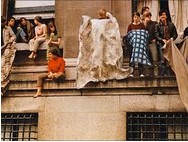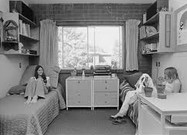从最初庄严肃穆的象牙塔式的宿舍楼,到如今弥漫着奢华之风的学生公寓,美国大学宿舍经历了翻天覆地的变化。现在,就随本文一起循着历史的足迹,来探寻美国大学宿舍的前世今生。
From the monastic rooms of the world’s first campuses to today’s luxury residence halls, let’s examine the ever-changing ways that students live.
从世界上最早的大学校园里那修道院式的小房间,到如今奢华的学生公寓,学生们的居住条件在不断地发生变化。现在就让我们一起来了解一下。
Student Seclusion 与世隔绝
Before the information superhighway, schools were built around massive libraries, like the 400-year-old Bodleian Library1) at the University of Oxford in Britain. Early dorms were imposing, monastic structures meant to separate students from the outside world, providing more privacy for classes and introspection2). This concept of the Ivory Tower3) lasted for decades. “If you look at the dorms of the Harvard Yard, the windows and doors are all on the yard side,” says Jonathan Zimmerman, director of the New York University’s History of Education Program. “Basically, what you see from the outside is a wall.”  在信息高速公路到来之前,学校都建造在大型图书馆旁边,比如拥有四百年历史的英国牛津大学博德莱安图书馆。早期的学生宿舍都是庄严肃穆的修道院式建筑,目的是把学生与外面的世界隔绝开来,为他们的学习与自省提供更清净的场所。这种“象牙塔”式的观念沿用了数十年。纽约大学教育史项目负责人乔纳森·齐默曼说:“如果你观察哈佛大学的学生宿舍楼,你会发现它的窗子和门都开在面向校园的一侧,从外面看,基本上只能看到一面墙。”
在信息高速公路到来之前,学校都建造在大型图书馆旁边,比如拥有四百年历史的英国牛津大学博德莱安图书馆。早期的学生宿舍都是庄严肃穆的修道院式建筑,目的是把学生与外面的世界隔绝开来,为他们的学习与自省提供更清净的场所。这种“象牙塔”式的观念沿用了数十年。纽约大学教育史项目负责人乔纳森·齐默曼说:“如果你观察哈佛大学的学生宿舍楼,你会发现它的窗子和门都开在面向校园的一侧,从外面看,基本上只能看到一面墙。”
Posters & Pin-ups4) 海报和美女招贴画
Traditionally, residence halls were occupied by male students who were forced to adhere to strict dress codes, compulsory chapel services, curfews5) and even fitness regimens6). Until the 1830s, Harvard students were required to purchase, chop and haul their own firewood back to the dorms. Dorm mothers enforced the rules, and executed a strict “lights-out” policy. Eventually, restrictions loosened and posters and pin-ups became standard dorm decor —a racy way to compensate for the lack of female presence.
在过去,大学宿舍里住的都是清一色的男生,他们被要求遵守严格的着装规范,必须去教堂做礼拜,遵守宵禁规定,甚至还要遵守保健和饮食方面的制度。直到19世纪30年代,哈佛大学还要求学生们自己买柴、劈柴,然后把木柴搬回宿舍取暖。舍监阿姨负责强制实施各项规定,并实行严格的“熄灯”政策。后来,这些规定有所松动,海报和美女招贴画开始出现在大学宿舍里,成为普遍的宿舍装饰物——这也成为男生们弥补校园内没有女生这一缺憾的独特方式。
Dorm Espionage7) 宿舍谍报
In the 1940s, with most of the country’s college-age men serving in World War II, more women began applying to universities—and getting accepted. Female-only dorms were erected, and if early rules for male students seemed harsh, the university guidelines for female co-eds8) were draconian9). Women were not allowed in male dorm rooms at any time, and curfews continued to dictate their movements around campus until well into the 1960s. But students found creative ways to skirt these restrictions; some sent messages to the opposite sex via Morse Code10) in the form of flashing lights across campus.
到了20世纪40年代,美国大多数的大学适龄男性都应征入伍,踏上了二战战场,于是更多女性开始申请进入大学,并被录取。女生宿舍也随之建造起来。如果说早期男生宿舍的规定比较严格的话,那么男女同校的大学对女生的要求则近乎苛刻了。女生在任何时间都不允许踏入男生宿舍半步,而且直到20世纪60年代,宵禁规定在一直发挥作用,限制着女生们在校园附近的活动。但是,学生们却找到了颇具创造性的方法来躲避这些约束:有些学生利用校园内的无线电信号发送摩尔斯代码,向异性传送消息。
All in the Family 全家出动
Thanks to the G.I. Bill11), World War II veterans and their wives flocked in droves to campuses across the country in the 1950s, where they lived in trailer parks and temporary bungalows that often lacked plumbing—accommodations that were still luxurious compared to the military barracks.
20世纪50年代,得益于《美国军人权利法案》的出台,二战退伍军人和他们的妻子纷纷涌入美国大学校园。他们居住在校园里没有通自来水管道的活动住房或临时搭建的平房里,但比起他们的军营来,这也算是“豪华住所”了。
AHigher-Ed Boom 高等教育的繁荣
The 1950s and 60s saw a surge in political and civil rights debates in America, with the college campus taking center stage12) in the debate over equality. In 1965, President Lyndon B. Johnson outlined his plans for affirmative action13) during a graduation speech at the historically all-black Howard University. Meanwhile, massive state and federal spending sparked a boom in dorm construction, as minorities and disadvantaged students began flocking to campuses nationwide. In 1958, the University of California’s nine campuses could house only 2,900 students; by 1970, they had residential space for nearly 20,000.
20世纪的50和60年代,美国掀起了关于政治权利与民权的辩论浪潮,而大学校园则成为人们辩论平等权利的中心场所。1965年,在历来只有黑人就读的霍华德大学的毕业典礼上,美国总统林顿·约翰逊提出了关于“反歧视行动”的构想。与此同时,随着少数民族和贫困学生开始大量涌入大学校园,州政府和联邦政府为学校提供了巨大的财政支持,由此带动了宿舍建设的热潮。1958年,加州大学的九个校区仅能容纳2,900名学生;到了1970年,加州大学的宿舍已经可以为近两万学生提供住宿了。
Bed-In14) 床上抗议
 As student activism spread across campuses in the late 1960s, female students began protesting gender segregation15)—not only in the dorms, but at schools in general. Women at Barnard College in Manhattan, the sister school to Columbia University, staged several protests called “bed-ins” to demand equal access to education.
As student activism spread across campuses in the late 1960s, female students began protesting gender segregation15)—not only in the dorms, but at schools in general. Women at Barnard College in Manhattan, the sister school to Columbia University, staged several protests called “bed-ins” to demand equal access to education.
20世纪60年代末,随着学生们在校园内掀起激进运动的热潮,女生们开始针对大学宿舍乃至整个校园里实行的性别隔离制度提出抗议。在位于曼哈顿的巴纳德大学(哥伦比亚大学的姊妹学校),女生们举行了被称做“床上抗议”的众多活动,要求享有平等的受教育权利。
Old Meets New 新旧交替
The cinder-block16) dorms of the 1950s were ill-equipped to handle the computer revolution of the 1980s. Re-wiring buildings became an expensive and drawn-out17) task, as did equipping their residents. Of today’s college students, writer Nicholas Carr says, “Facebook is the dorm; Wikipedia is the library; and Craigslist18) is the mall.”
20世纪80年代迎来了电脑革命的浪潮,50年代那些用空心砖建成的宿舍楼由于其配套设施陈旧落后而无法应对这一革命浪潮的到来。如此一来,为宿舍楼重新布线、为学生增添设备就成为一项投资大、耗时久的工程。说起当今的大学生,作家尼可拉斯·卡尔这样描述道:“Facebook就是他们的宿舍;维基百科就是他们的图书馆;‘克雷格列表’就是他们的购物中心。”
More Buck, More Bang19) 更多花费,更多回报
While state and federal funding dwindles and demand for college degrees continues to rise, tuition rates have soared—as has the need for better amenities20) to justify the higher expense. From 1995 to 2004, just 17% of the 113 residence halls constructed on college campuses were traditional dorms, according to the Association of College and University Housing Officers International; the vast majority were apartment-style suites.
州政府和联邦政府对大学的投入资金逐渐减少,而人们对于大学文凭的需求却持续升温,大学学费由此便飙升了起来。当然,为了使高额的学费“物有所值”,对更优越的生活设施的需求也随之增长。根据国际高校住宿官员联合会的统计,从1995年到2004年,美国高校建成的113栋学生宿舍中只有17%是传统的宿舍楼,其他的绝大多数都是公寓式的套间。
An Uphill Battle 日臻完善
Tanning salons, pool waterfalls, Mongolian grills, and hot tubs large enough for 15 people are some of the amenities offered at colleges across the country—like Boston University’s new 35-foot climbing wall. Sandy Baum, a senior analyst for the College Board, says students are driving the trend: “It’s not so much colleges wanting to be country clubs, it’s students who want to live in country clubs.”
日光浴沙龙、瀑布泳池、蒙古烤肉架、足以容纳15人的大浴缸—这些都只是美国大学提供的生活福利设施的一部分,像波士顿大学就新建了一面35英尺高的攀岩墙。大学理事会的高级分析员桑迪·博姆认为学生正在推动这股风潮:“并不是学校多么想成为乡村俱乐部,而是学生们想在乡村俱乐部里生活。”
Big Business 庞大产业
American Campus Communities surveys students each year to find out what they like. Since 1996, ACC has developed more than $1.5 billion in properties for university clients, and has acquired in excess of $2 billion in student-housing assets. Some critics argue such grand accommodations distract students from college’s real purpose. “The undergraduate university experience should be about getting kids to answer the basic question, ‘What is a life worth living?’” argues Jonathan Zimmerman, director of New York University’s History of Education Program. “By making all these lovely things for the kids, we’re answering that question for them.”
美国校园社区组织每年都会在学生中间开展调查,以找到他们的兴趣所在。从1996年至今,美国校园社区已为美国大学开发了总价值超过十五亿美元的房地产项目,并获得二十多亿美元的学生住房资产。一些评论家认为这样富丽堂皇的公寓分散了学生的注意力,使他们无法认识到来大学的真正目的。纽约大学教育史项目负责人乔纳森·齐默曼说:“本科的学习经历应当是探索和回答这样一个问题:‘什么样的人生是有价值的人生?’而我们现在为他们提供如此舒适的物质条件,就等于替他们回答了这个问题。
Rec21) at Rockoff 奢华之风
Rutgers University’s $55 million Rockoff Dorm features a Coldstone Creamery, a 7/11 and a state-of-the-art22) gym; residents also enjoy grocery delivery, room cleaning and laundry services. One hitch: Rockoff is only open to juniors and seniors. “If you have all the things you need in your own unit, you never go outside,” says Joan Carbone, Executive Director of Residence Life at Rutgers, who believes traditional dorms offer the best environment for freshmen interaction.
罗格斯大学的罗克夫学生公寓耗资5,500万美元,配备有冰石乳品厂、7/11便利店,以及当前设备最先进的健身房;住在这里的学生还可以享受杂货店的送货上门服务、房间清洁服务以及洗衣服务。唯一的问题是,这个公寓只对大三和大四的学生开放。罗格斯大学负责学生住宿工作的执行理事琼·卡波恩说:“如果公寓能满足学生的所有需求,那么学生就永远也不想出去了。”她认为传统宿舍才能为新生提供最适合交流的环境。
Bucking23) the Trend 反对之声
Not everyone agrees with the luxury-dorm fad. At Berea College in Kentucky, school administrators have adopted a unique approach to the problem of strangled24) budgets and coddled25) kids: Dorms are furnished by the college crafts workshops, cafeteria food is provided by the school’s farm, and students are required to work 10 hours a week in various campus jobs. “It’s about identity and the culture you want to develop,” says Gus Gerassimides, the college’s assistant vice president for student life. “Ultimately every community has choices to make. It’s who you choose to be.”
不是所有人都赞同时下学生公寓的奢华之风。在肯塔基州的伯利尔学院,学校管理人员采用了一种独特的方法来解决捉襟见肘的预算和好逸恶劳的学生之间的矛盾:学生公寓全部由校园手工艺工作室来配备家具和布置装饰,学校食堂的食物全部由校园农场来提供,学生可以从事不同的校园工作,每周必须工作十小时。学校主管学生生活的助理副校长古斯·格拉斯米德斯说:“问题在于你想创造怎样的校园和怎样的文化,最终每个学校都要作出选择,关键在于你选择成为什么。”
1. Bodleian Library:博德莱安图书馆,仅次于大英图书馆,位列英国三大版权图书馆之一,也是欧洲最古老的图书馆之一,馆内藏书达五百多万册。
2. introspection [7IntrEu5spekFEn] n. 内省,反省,自省
3. Ivory Tower:象牙塔;ivory [5aIvErI]n. 象牙
4. pin-up:招贴画,美女画像
5. curfew [5kE:fju:]n. 晚钟声,打晚钟时刻,宵禁令
6. regimen [5redVI7men]n.饮食起居制度
7. espionage [5espIE7na:V] n. 间谍,侦探,间谍行为
8. co-ed:(男女同学同校的)女生
9. draconian [dreI5kEJnIEn] adj. 严厉的
10. Morse code:摩尔斯电码(用于传送信息的一种代码,字母中的字或数字由各种不同排列的点、横、短标或长标表示)
11. G.I. Bill:《美国军人权利法案》,正式名称为“Servicemen’s Readjustment Act of 1944”,由美国总统富兰克林·罗斯福于1944年6月22日签署。该法案规定参与二战的军人可获得由失业保险支付的经济补贴以及多样化的教育机会。“G.I.”通常指美国大兵。
12. take center stage:成为引人注目的中心或公众瞩目的焦点
13. affirmative action:反歧视行动(保证美国受歧视的黑人、少数族裔和妇女享有教育和就业平等机会的积极措施,以纠正过去的歧视性政策或计划)
14. bed-in:床上抗议运动,最早由约翰·列侬和大野洋子于1969年发起。他们在阿姆斯特丹和蒙特利尔的酒店里,以在床上静坐两星期的方式抗议越南战争,倡导和平。
15. segregation [7se^rI5^eIFEn]n. (种族、性别或宗教的)隔离
16. cinder-block:(空心)煤渣砖
17. drawn-out:延长的,持续很久的
18. Craigslist:被誉为全球第一的分类广告网站,由美国人克雷格·纽马克(Craig Newmark)于1997年创建,该网站也由此被命名为“克雷格列表”。
19. more buck, more bang:这一用法来源于美国俚语“the bang for the buck ”(花钱换得的价值),在这里表示“更多花费,更多回报”。
20. amenity [E5mi:nItI]n. 生活福利设施,便利设施
21. rec [rek]n. 〈美〉娱乐,休闲
22. state-of-the-art:使用最先进技术的,当前最先进的
23. buck [bQk] vt. 坚决反对;拒绝继续
24. strangle [5strAN^l] vt. 限制,控制
25. coddle [5kRdl] vt. 娇养,溺爱
